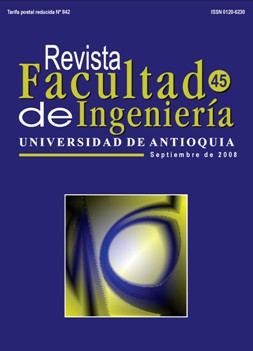Evaluation of the galvanic corrosion of high copper dental amalgams by means of electrochemical techniques
DOI:
https://doi.org/10.17533/udea.redin.18115Keywords:
dental amalgam, corrosion, galvanic corrosionAbstract
The galvanic interaction between three high copper dental amalgams with another four dental metallic materials, was evaluated. The dental amalgams were: a national Nu Alloy®dp (New Stetic) and two imported Contour®TM (Kerr, USA) and GS-80® (SDI, Australia). The dental metallic materials were: Titanium CP, Ti-6Al-4V type COC®, IPS d.sign 15® (Ni-Cr-Mo) and IPS d.sign 91® (Au-Pd). The evolution of the galvanic currents with time was measured using a Zero Resistance Ammeter equipment. The dental amalgams were characterized by means of Polarization Cyclical Measurements, and the evolution of the open circuit potentials of the dental amalgams allowed analyzing the nobility or activity of the amalgams in the test mean. The tests were done by triplicate in a three electrode cell and using the artificial physiological solution of Ringer as the electrolyte, the solution was deaerated at 37 ± 1°C. Under the test conditions, it is concluded that the home amalgam has the same tendency to undergo galvanic corrosion as comparison to imported amalgams. Using statistical ANOVA method of a single via it was corroborated the same electrochemical behavior of dental amalgams.
Downloads
References
J. L. Cova. Biomateriales Dentales. Ed. D’Vinni Ltda. Bogotá, Colombia. 2004. pp. 279-291.
D. Revelo. Informe semestre de práctica industrial en New Stetic. Informe de práctica. Medellín. 1995. pp. 9, 29-42.
Phillips. Ciencia de los materiales Dentales. 11ª ed. Ed. Elsevier. Madrid. 2004. pp. 495-541.
R. Craig. Materiales de odontología restauradora. 10 ed. Ed. Harcourt Brace. Madrid. 1998. pp. 209-236.
J. A. Muñoz. Diseño e implementación de una planta semipiloto para el tratamiento de residuos de amalgama dental. Informe de práctica. Medellín. 2004. pp. 21-38.
J. A. Arismendi. “Amalgama dental: obturación funcional o simple relleno cavitario?”. Revista Facultad de Odontología. Vol. 6. 1994. pp. 51-59.
A. Ciszewski, M. Baraniak, M. Urbanek-Brychczyńska. “Corrosion by galvanic coupling between amalgam and different chromium-based alloys”. Dental Materials. Vol. 23. 2007. pp 1256-1261.
E. Sutow, A. Wayne, J. C. Maillet, C. Taylor, G. C. Hall. “In vivo galvanic currents of inter¬mittently con¬tacting dental amalgam and other metallic restorations”. Dental Materials. Vol. 20. 2004. pp. 823-831.
A. Echavarría. Caracterización electroquímica de algunos implantes metálicos para uso en odontología. Tesis. Medellín. 2001. pp. 7-15, 57.
H. Mueller. “Tarnish and Corrosion of Dental Alloys”. ASM Handbook. Vol. 13. 1987. pp 1340-1341.
M. G. Fontana, N. D. Greene. Corrosion engineering.Ed. McGraw-Hill. New York. 1967. pp. 10-12.
D. Jonnes. Principles and Prevention of Corrosion. Macmillan. New York. 1992. pp. 101-176.
N. Horosawa, S. Takahashi, M. Marek. “Galvanic Interaction between ti-tanium and gallium alloy or dental amalgam”. Dental materials. Vol. 15. 1999. pp. 318-322.
M. Fathi, V. Mortazavi. “A Review on Dental Amal¬gam Corrosion and Its Consequences”. Journal of Re-search in Medical Sciences. Vol. 9. 2004. pp. 42-51.
R. Buddy, F. J. Schoen, J. E. Lemons, Biomaterials Science: An Introduction to Materials in Medicine. Academic Press. San Diego. 1996. pp. 1-2.
J. B. Park, R. S. Lakes. Biomaterials: an introduction. 2 ed. Plenum Press. New York.1992. pp. 1-5, 89-95.
P. Naylor. Introduction to Metal Ceramic Technology. Quintessence Books. Chicago. 1992. pp. 1-15, 27-38, 83-88.
W. S. Tait. An introduction to electrochemical corrosion testing for practicings engineers and scientists. Pair O Does. Wisconsin.1994. pp. 63-77.
Downloads
Published
How to Cite
Issue
Section
License
Revista Facultad de Ingeniería, Universidad de Antioquia is licensed under the Creative Commons Attribution BY-NC-SA 4.0 license. https://creativecommons.org/licenses/by-nc-sa/4.0/deed.en
You are free to:
Share — copy and redistribute the material in any medium or format
Adapt — remix, transform, and build upon the material
Under the following terms:
Attribution — You must give appropriate credit, provide a link to the license, and indicate if changes were made. You may do so in any reasonable manner, but not in any way that suggests the licensor endorses you or your use.
NonCommercial — You may not use the material for commercial purposes.
ShareAlike — If you remix, transform, or build upon the material, you must distribute your contributions under the same license as the original.
The material published in the journal can be distributed, copied and exhibited by third parties if the respective credits are given to the journal. No commercial benefit can be obtained and derivative works must be under the same license terms as the original work.










 Twitter
Twitter